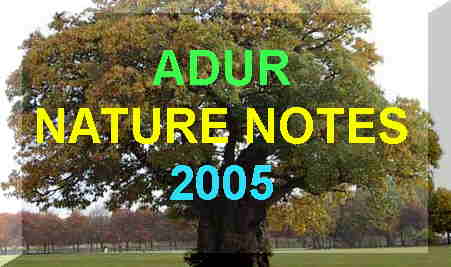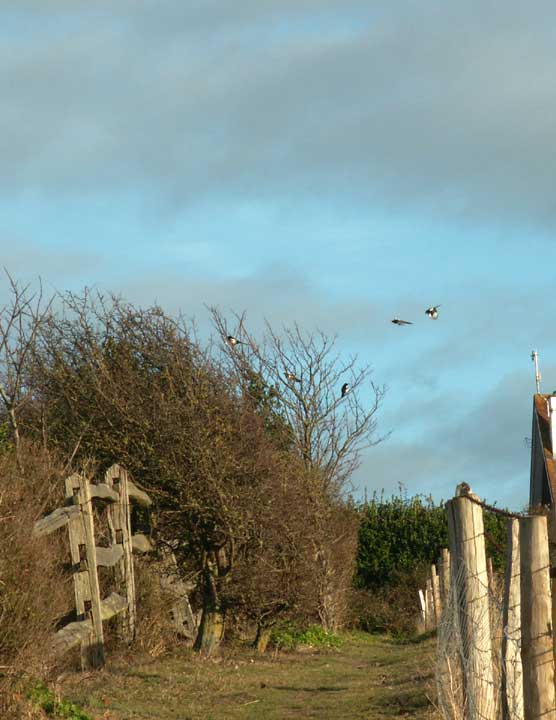 Pixie
Path
Pixie
Path Pixie
Path
Pixie
Path13
January 2006
There
were Wood Lice
(not Pill Bugs) under the discarded Chestnut fencing on the Pixie Path,
but I did not attempt to find put which species of isopod as they looked
like the common species found in gardens. These were my first terrestrial
arthropods (Crustacea) I have seen this year.
 |
There
appears to be new growths of the Cladonia
Pixie Cup Lichens on the broken chestnut
fencing at the top of the path by the tall garden hedge.
The green leaves are called "squamules" from which the "podentia" grow. I am not sure of the identity of these lichens without the reference but they could be Cladonia coniocrae. |
 22
November 2005
22
November 2005
Just
a Blue Tit
in the Hawthorn and a handful of Clubiona
spiders
and
a millipede were
spotted underneath the discarded Chestnut fencing. The photograph on the
right shows the small millipede
and what looks like a moth pupa.
8 November
2005
 |
 |
 |
All
the fungi recorded had been seen before and those identifications are used
again for a dozen or so Golden Wax Caps,
Hygrocybe
chlorophana, discovered
on the A27 road
embankment (Mill Hill Cutting) just east of the bridge section where it
crosses the
Waterworks Road; a handful of
clumps of the small Dermoloma mushrooms totalling about a
dozen on the Pixie Path approach to Mill
Hill from the Waterworks Road; and a small Panaeolus
sphinctrinus amongst the grass (not
the dung as usual which was not observed) on Frampton's Field.
Common
Wasps were occasionally seen amongst the
Ivy. The spider capsules of Clubiona
numbered about a half dozen.
17
& 23 October 2005
Common
Wasps were frequent around the Ivy much
more than in the previous years this century.
| The
miniature spider
in the pictures on the right emerged from the small white capsule underneath
the broken chestnut fence paling. It did not return to where it came from.
The poor quality images were because of its small size, under 10 mm (estimated)
in total length.
This
is a species of Clubiona.
The white capsule is a silken home spun by the spider. By 23
October 2005, there were five silken capsules,
but only one inhabited by the spider.
|
 |
 |
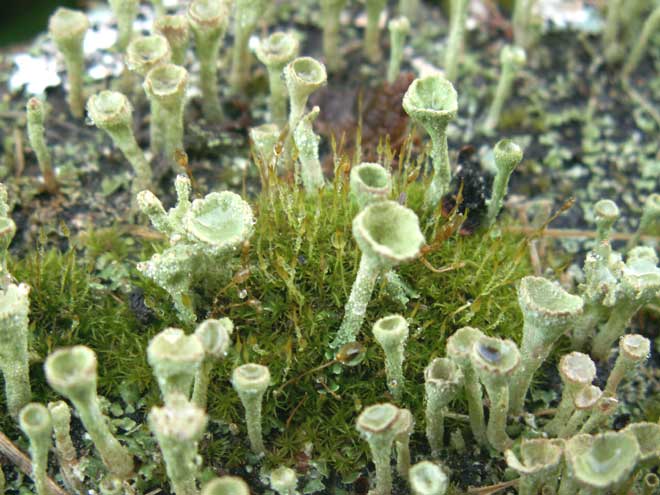
7 October
2005
About
ten Red Admiral Butterflies
were seen during the day with about eight of them on the Pixie Path route
to Mill Hill where a Painted
Lady made a brief appearance. A large
buff and brown fly, a possible Hornet Robber
Fly, Asilus
crabroniformis, landed on the path, but I was unable to confirm
this Biodiversity
Action Plan species with as close-up look.
Previous
Hornet Robber Report
 |
 |
Under the discarded chestnut paling fencing, there was a Lithobius centipede and the small spider illustrated above. The spider is juvenile Alopecosa species, almost certainly Alopecosa pulverulenta.
3 October
2005
A
dozen each of Common Wasps
and Drone Flies (hoverflies),
Eristalis
tenax, visited the Ivy and
Bramble
(with ripe blackberries).
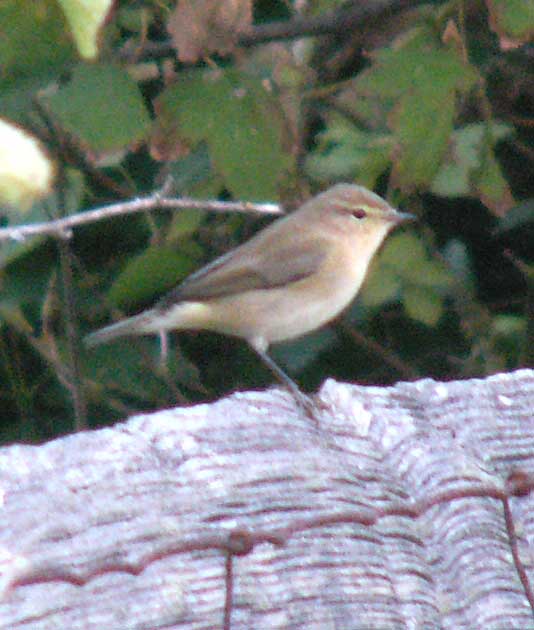 |
This
small bird was hiding amongst the Hawthorn
and shown in the photograph perched on the chestnut paling fence.
It was a Chiff-chaff, Phylloscopus collybita. It looked like it was making a home there, but time will tell as this small bird usually (99%+) migrates south in winter. These small insectivorous birds are resident in this immediate area throughout the summer. |
27
September 2005
The
vegetation had been recently cut and the path was now passable without
getting stung. Beware the steep and very dangerous drop down to the Waterworks
Road: the path has been eroded by Rabbits
and drops are hidden by the remaining vegetation.
 |
Left:
Red Admiral on Ivy next to the path in
the north-west corner of Frampton's Field.
The invertebrate in the is picture on the right is probably a pupa of a moth? |
 |
13
September 2005
In
Frampton's
Field (north of The Street, Old Shoreham) there was a large pile of
horse dung decorated by mushrooms. They looked
like Panaeolus
sphinctrinus to my inexperienced eye.
Shoreham
Fungi
 |
 |
 |
 |
Hoverflies
were less than expected at the lower end of the Pixie Path by the Butterfly
Copse. A handful of Drone Flies,
Eristalis,
flew
around
the Ivy. Yellow Wort
was still in flower in the early afternoon (this flower closes up later
in the day).
Just
one or two white butterflies
and a handful of Red Admirals
were recorded on top section of the Pixie Path by the garden hedge.
 30
August 2005
30
August 2005
There
were a handful each of Chalkhill Blues
(on
the Mill Hill Cutting), Common Blues
and Meadow Browns
with a surprise Brimstone Butterfly
at the top by the bridge.
21
August 2005
There
were seven male Chalkhill Blue Butterflies
in the extreme south-west corner of the Mill Hill Cutting. Other butterflies
were Common Blues
(12+) and Meadow Browns
with a Red Admiral
and a Speckled Wood.
The hoverfly Scaeva
pyrastri was noted with a handful
of common species. A Devil's Coach Horse
Beetle scuttled under the piece of disused
chestnut fencing next to Frampton's Fields.
 |
 |
Both these moths were recorded on the Pixie Path. The second one was a micro-moth. They
are the 2303 Straw Underwing Thalpophila
matura (hiding
on the underside of the discarded chestnut fencing)
and the 998 Light Brown Apple Moth Epiphyas
postvittana.
IDs
by
Peter
Hardy on UK Moths
Yahoo Group
|
16
August 2005
Twenty
Chalkhill
Blue Butterflies amongst the Autumn
Gentian and Horseshoe Vetch in the extreme
south-west corner of the Mill Hill Cutting is about as many as ever seen
in this area. There were none in Frampton's Field though; just about twenty
Common
Blues seen (more were hidden) and a handful
of Meadow Browns.
Butterfly
List for the Day
 |
 |
 |
 |
|
|
Female on the Mill Hill Cutting |
|
Female on the Mill Hill Cutting |
There were dozens of clumps of Eyebright next to the path. The Marmalade Fly was very frequent over a period of 30 minutes and the highest density of this prevalent hoverfly Episyrphus balteatus were around the shrubs bordering the Pixie Path. A Common Darter Dragonfly was seen. And a large Rabbit was resting in the middle of the overgrown path by the hedge at the top. It only scampered into the undergrowth when I got my camera out.
14
August 2005
The
Pixie Path produced a female Chalkhill
Blue Butterfly amongst the prostrate Horseshoe
Vetch leaves on the road bank. A couple of minutes later on the path, a
pair of courting Red Admirals,
a Gatekeeper,
a dozen Common Blues
and two Meadow Browns
were seen simultaneously. A Holly Blue
Butterfly settled. Later a dozen
more Common Blues
were amongst the Ragwort
on Frampton's Field. At least two Yellow
Shell Moths, a few more Meadow
Browns were seen in the vicinity of the path,
and a Wall Brown Butterfly
that rose from the chalk path and landed on the Chestnut palings fence.
On
the road bank, a dozen Autumn Gentian plants
were seen with the flowers closed.
7 August
2005
 |
 |
 |
Butterflies
on the path and in Frampton's Fields included Common
Blues
including females (could have been a Brown
Argus?), frequent Gatekeepers,
at least a dozen Meadow Browns,
one Essex Skipper,
one Chalkhill Blue
and some Whites.
 |
 |
 |
A cacophony
of stridulating green grasshoppers came
from the long grass of Frampton's Field (horse fields next to the
Pixie
Path).
The
first Autumn Gentian
was spotted just coming into flower on the road embankment of the Mill
Hill Cutting near the Pixie Path (south side of the A27).
Black
Ants with wings crawled under a discarded
fence of broken fencing. I expect they are
queens of Lasius
niger - the common Black Garden Ant.
31
July 2005
A
Red
Admiral Butterfly fluttered over the Pixie
Path. Gatekeeper
and Meadow Brown
Butterflies
were present, about a dozen were seen of each under an overcast sky. The
horse fields (did these used to be called Frampton's Fields?) were covered
in Ragwort where
the horses were not grazing.
8 July 2005
A tiny
ladybird
rescued from a spider's web was Halyzia
sedecimguttata
 |
 |
 |
|
|
|
on Wild Carrot |
24
June 2005
A
medium-to-large
dragonfly flew around the Ivy and then
zoomed off at a height of two metres plus without giving me a chance to
see it closely. It seemed to be dark brown-grey with the thorax appearance
of a Common Darter
but
about 20% larger.
 |
19
June 2005
Wild Thyme, Thymus polytrichus, and Bird's Foot Trefoil on the A27 road bank next to the Pixie Path. A dragonfly flew over, but I was not quick enough to see what species or even what colour? |
9 June
2005
The
stretch of the path running south to north from the Butterfly Copse was
becoming overgrown. Cut-leaved Cranesbill
was noted in flower in small patches and two Common
Blue Butterflies in the sunny mid-afternoon.
The ground hugging Milkwort
could still be seen although much larger flowers including Greater
Knapweed were easier to notice.
15
May 2005
Another
Nomada
fucata bee, possibly the same one
as before was noted in a passage visit.
9 May
2005
The
passage journey to Mill Hill along the
Pixie Path was slighter poorer than usual with a handful of Holly
Blue Butterflies and an equal number of
Speckled
Wood Butterflies.
Adur
Butterfly & Large Moth List 2005
 |
 |
 |
There
was a Common Lizard
under the loose piece of broken fencing with black
and red ants,
wood lice (isopods) and a millipede.
Another Nomada fucata bee
was skulking amongst the Stinging Nettles. The first fly in the photograph
is the Scorpion Fly,
Panorpa.
There were several in flight and amongst the Ivy.
The
wood lice are probably the Pill Bug,
Armadillidium
vulgare, (I need to see details
of the front of the head). It curls up into a ball so I surmised this species.
The
millipede
is probably Tachypodoiulus niger
if it has white legs. (It really needs the tip of tail magnified to identify
millipedes.)
 6
May 2005
6
May 2005
A
Wall
Brown Butterfly showed in the late afternoon.
I picked up the piece of fencing to see if there were any lizards
and found hundreds of both yellow and
black
ants. I think the yellow ants are probably
the superabundant species Lasius flavus
and the black ones the superabundant Lasius
niger.
1
May 2005
Two
passing visits on the Pixie Path during the day. The first visit registered
a Peacock Butterfly
just after in midday. Later in the afternoon, I nearly mistook the first
Wall
Brown Butterfly of the year for a Speckled
Wood, and I may made this mistake before?
There were one or two Green-veined White
Butterflies confirmed fluttering from
the path over the field.
Adur
Butterfly & Large Moth List 2005
There
was a bee with a bold contrasty yellow and black abdomen skulking near
a 10 cm diameter hole and avoiding the camera (the same one was seen on
the Shoreham
Bank before).
This unfamiliar yellow and black striped
small insect was probably the bee Nomada
fucata,
a kleptoparasite
of the mining bee Andrena flavipes.
Later a Common Carder
was seen in the same hole. A broken piece of fencing (a single piece halfway
up the path adjacent to the road and next to the field) was home for a
Common
Lizard with a full tail. There
was a new small mushroom.
29
April 2005
There
was a Peacock Butterfly
on the Pixie Path. And then a dark Common
Lizard with a full length tail skittered
rapidly over the fallen lichen-covered broken fence as a Pill
Bug (the wood-louse that rolls up into a ball)
crawled amongst the Cladonia Pixie
Cups.
 |
 |
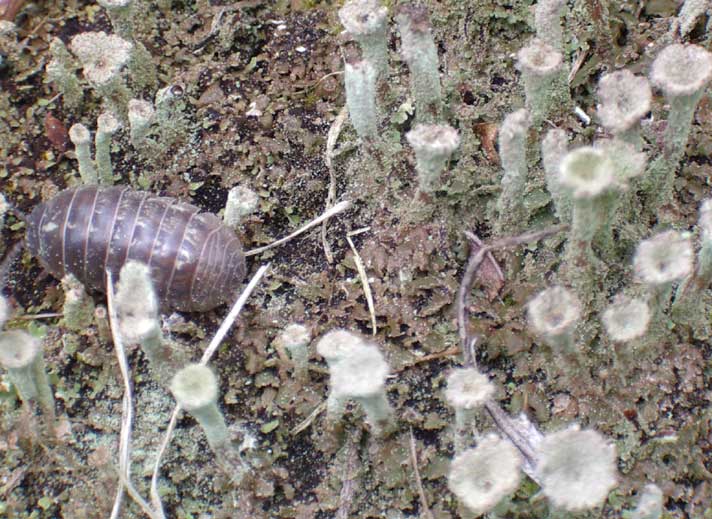 |
 |
There was a Queen Wasp and lots (a half dozen or more on one flower) of the abundant small flies Biblio sp.
27
April 2005
The
first Milkwort
flower of the year was seen on the side of the Pixie Path to Mill
Hill.
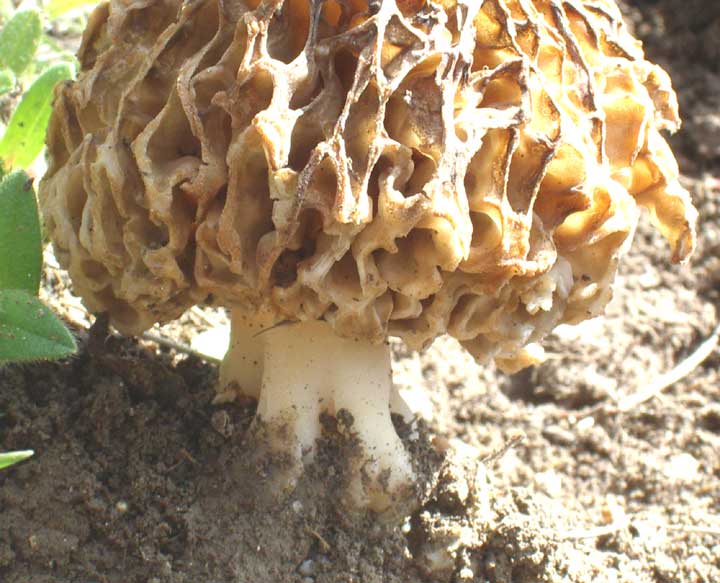 18
April 2005
18
April 2005
The
strange and unusual looking Morel
Mushroom,
Morchella esculenta,
was
seen on the side of the Pixie Path to
Mill
Hill. It looked dried out but I expect
they always look like this.
Fungi
of Shoreham
15
April 2005
These
flying insects were the frequent ones on the path running parallel with
the A27. Placing
a cursor over the image will reveal my identifications, which have not
been confirmed yet. The mating pair of Dung
Flies were from the Dovecote
Bank. The common* umbellifer Alexanders
was
attractive to half a dozen different flying insects. (* common on
the southern slopes of Mill Hill).
 |
 |
 |
 |
10
April 2005
The
first dozen Dog Violets
were in flower on the the Pixie Path to Mill
Hill, but on the lower slopes of Mill
Hill the Sweet Violet
was still the dominant flower with tens of thousands.
 |
 |
The
white spur and pointed sepals leave no question about the identification.
Adur
Violets
3 April
2005
It
was shirt sleeves weather in the afternoon sunshine on the warmest
(17.5 ºC) day of the year.
 |
 |
At
the turn (where the stile used to be) on the Pixie Path to Mill
Hill, the first Common Lizard,
Lacerta
viviparus, of the year basked in the sun
on a moss covered broken fence. The lizard's tail seemed short than its
full size. The lizard may have lost part of its tail and regrown it by
a process called autotomy.
Lizard
Images File
18
March 2005
 |
 |
16
March 2005
A
Small
Tortoiseshell Butterfly was disturbed
basking in the midday sun on the Pixie
Footpath adjacent to the horse fields
on the way to Mill Hill, and I was quick
enough to make a positive identification. This is the second probably of
the day and the first confirmed local sighting of 2005.
 |
 |
 |
 |
|
|
|
Mosses and lichens (above) on fallen fences proved difficult to photograph because of their small size and their apparent preference for the shade.
Adur
Lichens
Waterworks
Road and Pixie Path 2005
